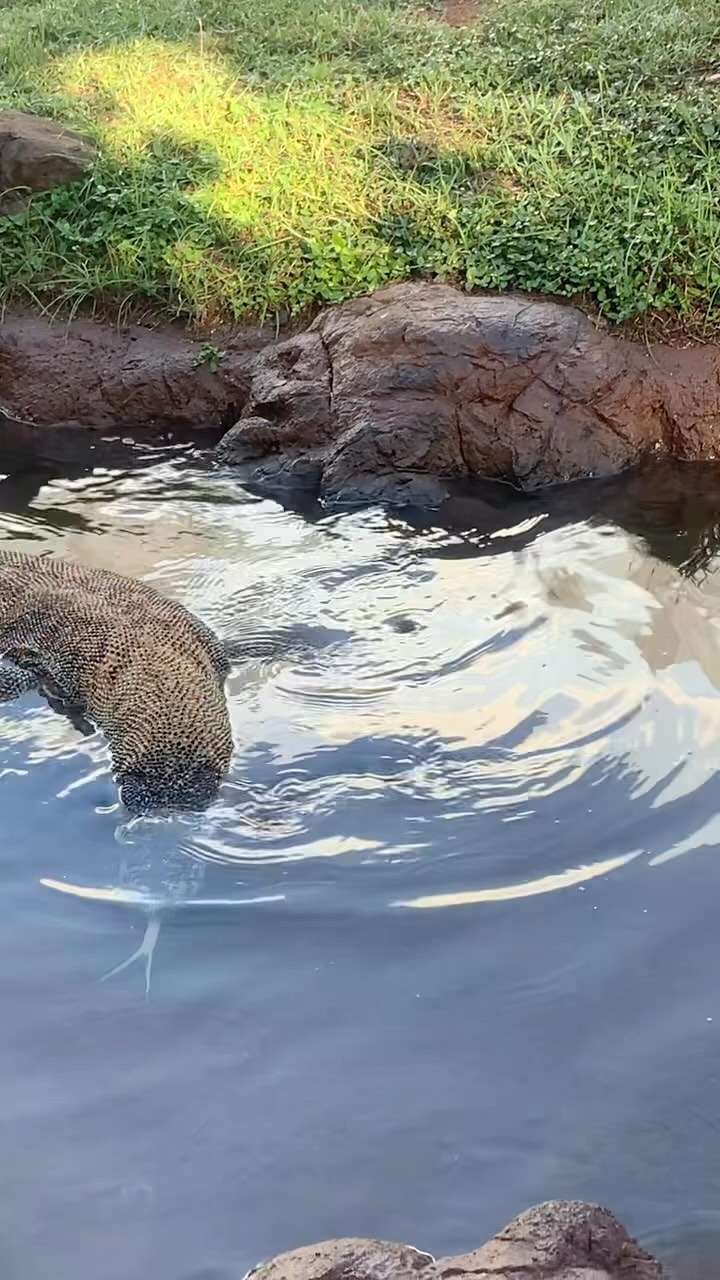- Komodo dragons are extraordinary animals known for their distinctive physical traits, including their size, powerful sense of smell, and serrated teeth.
- Beyond land-based hunting, Komodo dragons show exceptional aquatic capabilities, making them proficient swimmers with the ability to dive for food.
- Insights into the Komodo dragon’s habitat and conservation needs offer a perspective on preserving these creatures for future generations.
- Understanding the role of Komodo dragons in their ecosystem highlights their importance and the impact of their presence on biodiversity.
- Observations at places like the Honolulu Zoo provide valuable real-world examples of Komodo dragon behavior and abilities.
Komodo dragons stand out as remarkable members of the animal kingdom, capturing our attention primarily with their mammoth size and formidable hunting prowess. They are the largest living lizards, growing up to ten feet long and weighing as much as 150 pounds. Their sheer size alone garners interest, but their physical attributes and behaviors make them even more fascinating. Known for their potent bite, Komodo dragons possess serrated teeth that assist in tearing apart flesh, earning them a fearsome reputation in the wild.
Equipped with a keen sense of smell, Komodo dragons can detect carrion from nearly five miles away. This remarkable sensory ability is crucial for their survival, allowing them to locate food with efficiency that matches their predatory skills. Their forked tongues play a pivotal role in this, flicking in and out to sample airborne particles and send signals to the brain for processing, akin to a sixth sense.
Although Komodo dragons are often associated with their terrestrial life, they possess an unexpected proficiency in the water. These animals are capable swimmers, adept at navigating between islands in their native Indonesian habitat. This swimming capability is not solely for transportation; it also serves a practical purpose in hunting. Komodo dragons can dive underwater to pursue prey, adding a surprising dimension to their predatory arsenal. Their ability to swim effectively is a testament to their adaptability and resourcefulness.
The habitat of the Komodo dragon is limited to a few islands in Indonesia, including Komodo Island, Rinca, and Flores. These environments provide not only the necessary space for their large bodies but also the diverse prey they require. The ecosystems here are delicate, with Komodo dragons playing a critical role as apex predators. Their presence helps maintain the balance of species, influencing the population dynamics of various animals, from deer to smaller mammals.
However, these ecosystems face threats from human activities, necessitating conservation efforts to protect the Komodo dragon and their habitat. Habitat destruction and the reduction of available prey due to human encroachment have put pressure on these majestic creatures. Conservation programs aim to mitigate these impacts, focusing on habitat preservation and increasing awareness about the Komodo dragon’s plight. Protective measures are vital for ensuring that these remarkable animals do not dwindle in number.
The importance of conservation is underscored by institutions like the Honolulu Zoo, which house and care for Komodo dragons. Observing these lizards in a controlled environment offers insights into their behaviors and helps educate the public about their natural history and conservation needs. At the Honolulu Zoo, visitors can witness Komodo dragons demonstrating their natural swimming abilities, diving for fish in their pool with grace and precision. Such firsthand experiences enhance public understanding of these formidable reptiles, fostering a greater appreciation that is crucial for their conservation.
Understanding the ecosystem role of Komodo dragons reveals their significance beyond their imposing presence. These lizards are integral to the trophic web, influencing not just smaller predators but also the prey species. Their hunting activities can dictate the population sizes of various animals, maintaining a natural equilibrium. The loss of Komodo dragons could lead to overpopulation of certain species, ultimately upsetting the ecological balance.
Efforts to preserve the Komodo dragon require a multi-faceted strategy. This includes safeguarding their natural habitats, curbing illegal poaching, and promoting sustainable land-use practices. Conservationists are developing strategies that engage local communities, recognizing that their partnership is essential to successful long-term conservation. Raising awareness and education among local populations can significantly contribute to creating protective measures that benefit both humans and wildlife. Effective conservation efforts blend scientific research with community involvement, ensuring that conservation practices are both informed and practical.
In summary, the Komodo dragon is a marvel of nature, a creature of immense power and adaptability. Their ability to thrive on land and water showcases their versatility, and their role within the ecosystem emphasizes their importance in biodiversity. Conservation efforts remain crucial to safeguard these extraordinary animals for future generations. By observing Komodo dragons and understanding their needs, we can contribute to their preservation and ensure they continue to awe and intrigue us with their capabilities.
*****
Source Description
Komodo dragons are amazing animals known for their large size, great sense of smell, serrated teeth, and hunting abilities. But did you know Komodo dragons are also excellent swimmers? 🏊♂️🌊 These incredible creatures can swim between islands and dive to hunt for food. At the Honolulu Zoo, our three Komodo dragons showcase their natural swimming skills by diving for fish in their pool! 🐟🐾


